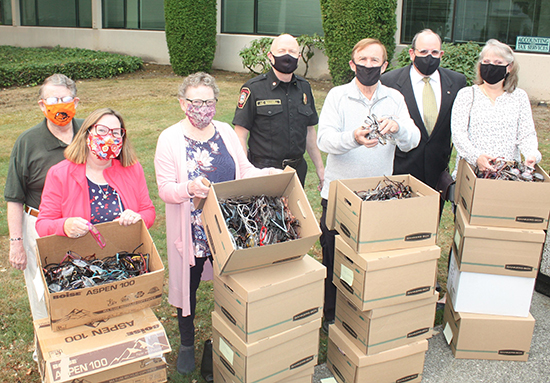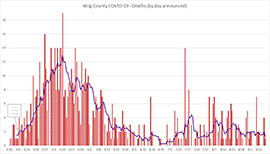
Dear Friends:
Today’s update includes information on my recent visit to the Federal Way Kiwanis Club to donate eyeglasses, an Eviction Protection and Rental Assistance Webinar this evening, King County Metro’s upcoming service changes in South King County, and more.
Washington Trivia
When was the incorporation of Black Diamond?
(Answer is at the bottom).

Federal Way Kiwanis Club Glasses Donation
This week I donated over 1,500 prescription glasses, sunglasses, and cases to the Federal Way Kiwanis Club. For more than twenty years, I have been partnering with King County Metro to donate glasses lost on Metro buses to community organizations in South King County, as the cost of glasses can often be a barrier to many of our neighbors. Thanks to Metro and the Kiwanis Club for all the work they are doing for our community during this challenging period.

Photo with Andrew Urban, Susan Honda, Linda Persha, Gordy Goodsell, Mike Brugato and Karen Brugato of the Federal Way Kiwanis Club
Eviction Protection and Rental Assistance Webinar this evening
The King County Eviction Prevention and Rental Assistance Program will be hosting a webinar this evening, September 17th, at 6:00 PM, for King County tenants in need of rental assistance. This webinar will provide an overview of the program and review the expected process for tenants. During the webinar, participants will be able to ask questions of King County staff managing the program. King County is scheduling Spanish and Somali interpreters for this webinar. Click here to register for this webinar.
King County Metro offers more reliable transportation in South King County
This Saturday, September 19th, Metro is changing routes in South King County and will debut Route 160, which connects Renton, Kent, and Auburn and will convert into the RapidRide I line in a few years. Additionally, Metro is adding more evening and weekend service for shift workers, better east-west connections and integration with Sounder Commuter Rail, and faster travel times and direct service to key destinations where possible. Learn more about what’s changing and check whether your route is affected at www.kingcounty.gov/GetReady. Riders also can call customer service for trip planning assistance at 206-553-3000 from 6 a.m. to 8 p.m. Monday through Friday, and Metro’s trip planner is available online.
Wildfire smoke remains likely through the end of the week
As wildfires continue to rage in Washington and neighboring states, the air quality in Seattle and King County remains at unhealthy levels. Pollutants in smoke cause burning and watery eyes, coughing, throat and sinus irritation, and other symptoms. In addition, it can aggravate heart and lung diseases and can be very challenging for those with asthma, COPD, and other health conditions. Visit AirNow to check the air quality index and forecast for your city.

COVID-19 activity declining in Washington with the help of face coverings and distancing
According to the latest statewide situation report released by the Washington state Department of Health, there is an overall decline in COVID-19 activity as of late August. It highlights that keeping our distance, limiting gathering size, and wearing face coverings are working to slow the spread of the disease.
As of August 28th, the reproductive number Ro that measures how many new people each COVID-19 patient will infect was close to one in western Washington and above one in eastern Washington. The goal is a number well below one, which would mean COVID-19 transmission is declining. In King County, the latest Ro estimate is at 0.6. Additionally, cases in King County have recently dropped to 65 cases per 100,000 population, after a peak of 115 cases per 100,000 at the end of July.
King County Case Update
As of yesterday, Seattle – King County Public Health reported 145 new cases, bringing the total in King County to 21,158. In addition, Public Health reported 1 new death, bringing the total in the county to 748.
 |
 |
|---|---|
 |
 |
Stay In. Stay Healthy. Stay Strong.
Pete von Reichbauer
King County Councilmember

Washington trivia answer:
Built in the 1880s as a company town for the Black Diamond Coal Company, Black Diamond was incorporated on February 19, 1959. According to HistoryLink, the coal company was originally based in Nortonville, California, but when coal was discovered in the Washington Territory, a representative was sent north to inspect the area. The coal tested well, so the company sent their crew to homestead and set up operations. In order to bring heavy machinery, they built a railroad southeast from Renton.
By 1884, families and workers started moving from California, with most of them being first-generation Americans of Italian or Welsh descent. The Welshmen were known to come from a line of coal miners in their native land, allowing them to get better pay as they executed tasks that required more skill.
Black Diamond was considered a company town, with the company owning mostly everything in the area and leasing the land to workers and families. Though coming from different ethnic groups, the people in town enjoyed their time together and would sometimes have “Around the World” bazaars featuring their traditional foods. However, in 1904, the Pacific Coast Company based in New York bought the mine and the town. Working conditions and wages later became an issue, and the demand for coal eventually was defeated by oil.
|
Contact me:
pete.vonreichbauer@kingcounty.gov |
 |